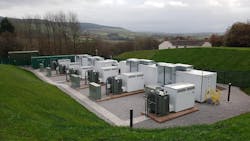Adopting Predictive Maintenance Practices for Battery Energy Storage System Safety
At times, energy storage development in the electric power industry has preceded the formulation of best practices for safety and operating procedures.
System integrators, utilities, government bodies, and professional organizations have put considerable effort into developing safety standards and best practices for the engineering, installation, and commissioning of grid-scale battery energy storage systems (BESSs). However, recent incidents in systems that have been operational for months or years have revealed the limitations of current industry safety practices.
Current State of the Energy Storage Industry
ESSs are certified according to specific codes and standards that focus on an overall design review of the ESS, testing for pre-shipment adherence to standards, and commissioning after the unit is installed. Ideally:
- The certification process ensures the system design is sound.
- The factory testing ensures the unit is constructed correctly.
- The commissioning test ensures there are no faults discovered after the unit is installed.
However, guidance on long-term maintenance after the project is commissioned represents a critical gap that must be addressed.
Improving Operation Through Predictive Maintenance
Preventive and predictive maintenance are mature concepts for operational systems in industry. Operators complete preventive maintenance on a routine schedule based on average or expected lifetime statistics for equipment. Predictive maintenance is carried out when needed based on the actual condition of the equipment. Components are monitored for changes in operating parameters that may be indicative of a pending fault, and these changes prompt intervention.
Some organizations have offered general guidance on preventive maintenance for BESSs, including: visual inspections of the overall system, examining the cooling and fire suppression systems, and checks on the ESS software control and communications. Some propose an annual process similar to commissioning.
To date, business and technical challenges have hindered broader adoption of predictive maintenance in BESSs. The practice has proven fruitful in other sectors of the power industry. For example, utilities have saved millions via early detection of cracks in gas turbine blades and rotors. Additionally, many wind turbine operators now use predictive analytics to monitor the health of gearboxes (where failure can cost over $350,000 per incident). However, the nascence of the BESS industry means less data on fault patterns, making data analytics more difficult. Furthermore, pressure to keep the cost per kWh as low as possible means less investment in sensors and infrastructure to process large volumes of data.
Our recent article in IEEE Power and Energy Magazine offered a basic roadmap for establishing a predictive maintenance approach for a BESS. This approach relies on the identification of possible indicator-fault relationships during the design phase (for example, via a failure mode and effects analysis) and seeking new relationships via continuous post-processing of field data (for example, using data science paradigms). We highlight how an energy storage integrator leveraged this approach to (1) identify misbehaving battery modules before they caused any issues and (2) save on maintenance costs by allowing the service team to plan visits more efficiently in each geographic region.
In summary, the next step in improving BESS safety and operations is an industry shift to a predictive monitoring and maintenance process. Predictive maintenance is already employed in other utility applications such as power plants, wind turbines, and PV systems. This process complements current BESS codes and standards, and also contributes to broader efforts to design safer systems.
For a more in-depth exploration of this topic, read the following article in IEEE Power and Energy Magazine: https://ieeexplore.ieee.org/document/9228907
An unformatted copy for those without IEEE access is available here.
About the Author
Yuliya Preger
Yuliya Preger is a senior member of technical staff in the Energy Storage Technology and Systems Group at Sandia National Labs. Her current work is centered on the safety and reliability of Li-ion and aqueous batteries for grid-level energy storage applications. She is co-founder of batteryarchive.org, the first public repository for easy visualization of lithium-ion battery degradation data across institutions. She earned her PhD and BS in chemical engineering from the University of Wisconsin-Madison and MIT, respectively.

